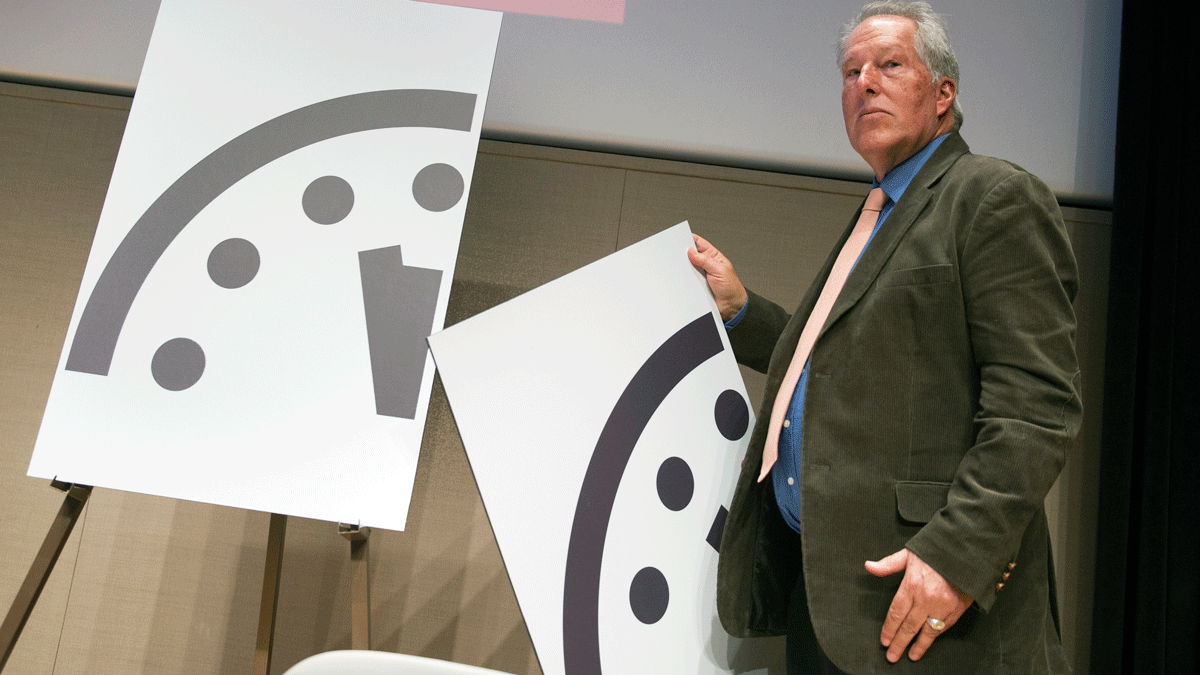
These failures of political leadership endanger every person on Earth. "World leaders have failed to act with the speed or on the scale required to protect citizens from potential catastrophe. "In 2015, unchecked climate change, global nuclear weapons modernizations, and outsized nuclear weapons arsenals pose extraordinary and undeniable threats to the continued existence of humanity," read a statement from the Bulletin of the Atomic Scientists.

Maintained since 1947, the clock is a metaphor for threats to humanity from unchecked scientific and technological advances. We're now in an equally dangerous place, according to the scientists, for the first time in more than 20 years. The Doomsday Clock is a symbol that represents the likelihood of a man-made global catastrophe, in the opinion of the members of the Bulletin of the Atomic Scientists. Its current setting is (as of 24th January 2020) at. The comic series Watchmen used a representation of the clock prominently to portray a world on the brink of disaster and the drastic steps its heroes used to save it. Its setting as of the publication of this comic was at three minutes to midnight (11:57 PM or 23:57).

In 1947, the Bulletin of the Atomic Scientists published, on its cover, a Doomsday Clock. It has only been closer to midnight once, in 1953, when both the United States and Soviet Union were testing thermonuclear weapons. The Doomsday Clock in 2002, when it was set at 11:53. It has been at three minutes in 1984 during the Cold War, and in 1949 when the Soviet Union tested its own atomic bomb. This makes the current position tied for the second-closest it's ever been, says io9. The closer to midnight, the closer we're said to be to a global catastrophe. It has been at five minutes to midnight since 2012, when it was moved up from six due to concerns about nuclear safety. and Soviet Union.Io9 reports that The Bulletin of the Atomic Scientists, which administers the clock, cited global warming and nuclear proliferation as its reasoning behind the move. For example, in 1960, the clock was moved back to seven minutes to midnight, thanks in large part to new cooperation between the U.S. Over the years, the clock has been moved forward and backward to reflect changes and improvements in the world's ability to prevent nuclear proliferation and work to mitigate climate change. That year, the clock was set at two minutes to midnight. and the Soviet Union both tested hydrogen bombs. The closest the Doomdsay Clock got to midnight was in 1953, when the U.S. When the clock started running, it was set at seven minutes to midnight. Clearly something has to be done on an state of emergency basis.

Two years later, following the bombings of Hiroshima and Nagasaki, the BAS designed the Doomsday Clock to alert the public to the dangers of nuclear proliferation. Today, they have been forced to push the hands forward to only three minutes to midnight. The BAS was created in 1945 by scientists who helped develop the atomic bomb during the Manhattan Project. "We, the members of the Science and Security Board of the Bulletin of the Atomic Scientists, want to be clear about our decision not to move the hands of the Doomsday Clock in 2016: That decision is not good news, but an expression of dismay that world leaders continue to fail to focus their efforts and the world's attention on reducing the extreme danger posed by nuclear weapons and climate change." Far too close," the organization said in a statement.

last year - will remain at the closest it's been to midnight since 1984, when the Cold War was at its iciest. T he Doomsday Clock remains at three minutes to midnight, the closest to the brink of global destruction since the height of the Cold War. As a result, the clock - which was moved up two minutes to 11:57 p.m.


 0 kommentar(er)
0 kommentar(er)
